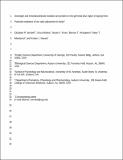Files in this item
Androgen and mineralocorticoid receptors are present on the germinal disc region in laying hens : potential mediators of sex ratio adjustment in birds?
Item metadata
| dc.contributor.author | Wrobel, Elizabeth R. | |
| dc.contributor.author | Molina, Erica | |
| dc.contributor.author | Khan, Nicola Y. | |
| dc.contributor.author | Akingbemi, Benson T. | |
| dc.contributor.author | Mendonca, Mary T. | |
| dc.contributor.author | Navara, Kristen J. | |
| dc.date.accessioned | 2020-12-07T15:55:27Z | |
| dc.date.available | 2020-12-07T15:55:27Z | |
| dc.date.issued | 2020-02-01 | |
| dc.identifier | 264192806 | |
| dc.identifier | 42bf3146-26ed-4751-bca6-002f2c006528 | |
| dc.identifier | 85075977287 | |
| dc.identifier | 000509420000002 | |
| dc.identifier.citation | Wrobel , E R , Molina , E , Khan , N Y , Akingbemi , B T , Mendonca , M T & Navara , K J 2020 , ' Androgen and mineralocorticoid receptors are present on the germinal disc region in laying hens : potential mediators of sex ratio adjustment in birds? ' , General and Comparative Endocrinology , vol. 287 , 113353 . https://doi.org/10.1016/j.ygcen.2019.113353 | en |
| dc.identifier.issn | 0016-6480 | |
| dc.identifier.other | RIS: urn:84964179DAE54A8A99148F0BD8816AB6 | |
| dc.identifier.uri | https://hdl.handle.net/10023/21080 | |
| dc.description | This work was funded by a National Science Foundation grant (award # 1456442). | en |
| dc.description.abstract | Female birds skew offspring sex ratios based on environmental and social stimuli; however, the mechanism mediating this phenomenon remains unknown. Growing evidence suggests that testosterone and corticosterone may influence meiosis, as they skew sex ratios when given immediately before chromosomal segregation. It is unclear if these hormones act on the germinal disc (GD) or through a downstream mediator. It is also unknown whether the GD contains receptors for these hormones. If testosterone and/or corticosterone act on the GD to skew sex ratios, then the GD should have receptors for them and that receptor levels should be higher in the GD regions compared to other follicular regions. Furthermore, fluctuations of receptor levels should occur near meiotic segregation. We collected ovarian follicles at 5h pre-ovulation (just before meiotic segregation) and 20h pre-ovulation (when sex chromosomes are arrested), and measured androgen receptor (AR) and mineralocorticoid receptor (MR) protein levels via Western blot. ARs and MRs were on the follicle in the GD and non-GD regions, and at 5h and 20h pre-ovulation. Both AR and MR protein levels were higher in the GD region than the non-GD region at both time points, but did not differ between time points. These results suggest that hen ovarian follicles have receptors for testosterone and corticosterone, and that the ability for testosterone to respond may be specifically higher in the GD-region, providing further support for the role of testosterone in the alteration of meiotic segregation. | |
| dc.format.extent | 316178 | |
| dc.language.iso | eng | |
| dc.relation.ispartof | General and Comparative Endocrinology | en |
| dc.subject | Androgen receptor | en |
| dc.subject | Mineralocorticoid receptor | en |
| dc.subject | Testosterone | en |
| dc.subject | Corticosterone | en |
| dc.subject | Sex ratio | en |
| dc.subject | Maternal effects | en |
| dc.subject | Chickens | en |
| dc.subject | Birds | en |
| dc.subject | Avian | en |
| dc.subject | Hormones | en |
| dc.subject | QH301 Biology | en |
| dc.subject | NDAS | en |
| dc.subject.lcc | QH301 | en |
| dc.title | Androgen and mineralocorticoid receptors are present on the germinal disc region in laying hens : potential mediators of sex ratio adjustment in birds? | en |
| dc.type | Journal article | en |
| dc.contributor.institution | University of St Andrews. School of Psychology and Neuroscience | en |
| dc.identifier.doi | 10.1016/j.ygcen.2019.113353 | |
| dc.description.status | Peer reviewed | en |
| dc.date.embargoedUntil | 2020-12-04 |
This item appears in the following Collection(s)
Items in the St Andrews Research Repository are protected by copyright, with all rights reserved, unless otherwise indicated.

